The Properties of Micro Carbon Fiber Composite Modified High-Viscosity Asphalts and Mixtures
Abstract
:1. Introduction
2. Materials and Methods
2.1. Materials
2.1.1. Raw Materials
2.1.2. Preparation of Modified Asphalt
2.1.3. Aggregate
2.1.4. Asphalt
2.1.5. Modified Asphalt Mixture Gradation
2.1.6. Tests for Modified Asphalt
- (1)
- Penetration, Softening Point, Ductility, viscosity, and toughness tests
- (2)
- Brookfield viscosity
- (3)
- Dynamic shear rheological test (DSR)
- (4)
- Multiple stress creep recovery test (MSCR)
- (5)
- Bending beam rheometer test (BBR)
2.1.7. Tests for Asphalt Mixture
- (1)
- Rutting test
- (2)
- Low temperature bending test
- (3)
- Freeze-thaw splitting test
- (4)
- Four-point bending fatigue test and digital image correlation test
- (5)
- The bending fatigue test
- (6)
- Anti-skid and water seepage test
3. Results and Discussion
3.1. Three Indexes and Viscosity and Toughness
3.2. Rheological Properties of the Composite-Modified Asphalts
3.2.1. Brookfield Viscosity
3.2.2. High-Temperature Rheological Property
3.2.3. Elastic Resilience
3.2.4. Low-Temperature Creep Properties
4. Asphalt Mixture Road Performance
4.1. High-Temperature, Low-Temperature, and Water Stability Test
4.2. Fatigue Property
4.3. Anti-Slip and Anti-Water Seepage Properties
5. Conclusions
- (1)
- Based on the evaluation of DSR, BBR, and MSCR tests, the high and low temperature properties and the viscosity of the prepared modified asphalt were significantly improved compared with the SBS-modified asphalt. The optimal dosage combination was 6% SBS + 0.8% MCF, 5% SBS + 2% SBR + 0.8% MCF.
- (2)
- According to the results of rutting, low-temperature trabecular bending failure, freeze-thaw splitting, four-point bending fatigue, and speckle tests, the prepared modified asphalt can improve the high-temperature stability, low-temperature crack resistance, water stability, and fatigue performance of an asphalt mixture, and the performances of 6% SBS + 0.8% MCF and 5% SBS + 2% SBR + 0.8% MCF-modified asphalt mixture were the best.
- (3)
- The anti-skid and water seepage tests show that the modified asphalt prepared in this study provided excellent and durable skid resistance for the ultra-thin overlays, which greatly increases driving safety.
Author Contributions
Funding
Institutional Review Board Statement
Informed Consent Statement
Data Availability Statement
Acknowledgments
Conflicts of Interest
References
- Yu, J.; Yang, N.; Yu, H. Research and application status of high-performance asphalt ultra-thin wearing layer technology. J. Cent. South Univ. (Sci. Technol.) 2021, 52, 2287–2298. [Google Scholar]
- Kandhal, P.S.; Lockett, L. Construction and Performance of Ultrathin Asphalt Friction Course; NACT Report No 97-5; Nation Center for Asphalt Technology, Auburn University: Auburn, AL, USA, 1997. [Google Scholar]
- Chen, Y.; Tebaldi, G.; Roque, R.; Lopp, G.; Exline, M. A mechanistic test to evaluate effects of interface condition characteristics on hot-mix asphalt overlay reflective cracking performance. Road Mater. Pavement Des. 2013, 14, 262–273. [Google Scholar] [CrossRef]
- Kim, Y.K.; Lee, S.W. Performance evaluation of bonded concrete overlay. Constr. Build. Mater. 2013, 49, 464–470. [Google Scholar] [CrossRef]
- Qian, G.; Li, S.; Yu, H.; Gong, X. Interlaminar Bonding Properties on Cement Concrete Deck and Phosphorous Slag Asphalt Pavement. Materials 2019, 12, 1427. [Google Scholar] [CrossRef] [PubMed] [Green Version]
- Jing, L.; Zhang, F.; Liu, Y.; Yaseen, M. Preparation and properties of soybean bio-asphalt/SBS modified petroleum asphalt. Constr. Build. Mater. 2019, 2012, 68–277. [Google Scholar]
- Jiang, W.; Yuan, D.; Shan, J. Experimental study of the performance of porous ultra-thin asphalt overlay. Int. J. Pavement Eng. 2020, 23, 2049–2061. [Google Scholar] [CrossRef]
- Zhao, Q.; Lu, X.; Jing, S.; Liu, Y.; Hu, W.; Su, M.; Wang, P.; Liu, J.; Sun, M.; Li, Z. Properties of SBS/MCF-Modified Asphalts Mixtures Used for Ultra-Thin Overlays. Coatings 2022, 12, 432. [Google Scholar] [CrossRef]
- Yu, H.; Zhu, Z.; Zhang, Z.; Yu, J.; Oeser, M.; Wang, D. Recycling waste packaging tape into bituminous mixtures towards enhanced mechanical properties and environmental benefits. J. Clean. Prod. 2019, 229, 22–31. [Google Scholar] [CrossRef]
- Yu, J.; Ren, Z.; Gao, Z.; Wu, Q.; Zhu, Z.; Yu, H. Recycled Heavy Bio Oil as Performance Enhancer for Rubberized Bituminous Binders. Polymers 2019, 11, 800. [Google Scholar] [CrossRef] [PubMed] [Green Version]
- Song, l.; Wang, Z.; Shu, C. Research progress and performance evaluation of SBS/SBR-modified asphalt. China J. Highw. Transp. 2021, 34, 17–33. [Google Scholar]
- Liang, M.; Xin, X.; Fan, W. Investigation of the rheological properties and storage stability of CR/SBS modified asphalt. Constr. Build. Mater. 2015, 74, 235–240. [Google Scholar] [CrossRef]
- Zhang, Z.; Cheng, P.; Yang, Z. Self-healing properties of nano-montmorillonite-enhanced asphalt binders from the perspective of energetics and morphology. Mater. Struct. 2021, 54, 77. [Google Scholar] [CrossRef]
- Zaghloul, M.M.Y.; Zaghloul, M.Y.M.; Zaghloul, M.M.Y. Experimental and modeling analysis of mechanical-electrical behaviors of polypropylene composites filled with graphite and MWCNT fillers. Polym. Test. 2017, 63, 467–474. [Google Scholar] [CrossRef]
- Zaghloul, M.M.Y.; Zaghloul, M.M.Y. Influence of flame retardant magnesium hydroxide on the mechanical properties of high-density polyethylene composites. J. Reinf. Plast. Compos. 2017, 36, 1802–1816. [Google Scholar] [CrossRef]
- Zaghloul, M. Mechanical properties of linear low-density polyethylene fire-retarded with melamine polyphosphate. J. Appl. Polym. Sci. 2018, 135, 46770. [Google Scholar] [CrossRef]
- Zaghloul, M.Y.M.; Zaghloul, M.M.Y.; Zaghloul, M.M.Y. Developments in polyester composite materials—An in-depth review on natural fibres and nano fillers. Compos. Struct. 2021, 278, 114698. [Google Scholar] [CrossRef]
- Fuseini, M.; Zaghloul MM, Y.; Elkady, M.F.; El-Shazly, A.H. Evaluation of synthesized polyaniline nanofibres as corrosion protection film coating on copper substrate by electrophoretic deposition. J. Mater. Sci. 2022, 57, 6085–6101. [Google Scholar] [CrossRef]
- Wang, P.; Dong, Z.; Tan, Y. Effect of multi-walled carbon nanotubes on the performance of styrene–butadiene–styrene copolymer modified asphalt. Mater. Struct. 2017, 50, 17. [Google Scholar] [CrossRef]
- Zhang, K.; Liu, Y.; Nassiri, S. Performance evaluation of porous asphalt mixture enhanced with high dosages of cured carbon fiber composite materials. Constr. Build. Mater. 2021, 274, 122066. [Google Scholar] [CrossRef]
- Khattak, M.; Khattab, A.; Rizvi, H. The impact of carbon nano-fiber modification on asphalt binder rheology. Constr. Build. Mater. 2012, 30, 257–264. [Google Scholar] [CrossRef]
- Eisa, M.S.; Mohamady, A.; Basiouny, M.E.; Abdulhamid, A.; Kim, J.R. Mechanical properties of asphalt concrete modified with carbon nanotubes (CNTs). Case Stud. Constr. Mater. 2022, 16, e00930. [Google Scholar]
- Khattak, M.; Khattab, A.; Rizvi, H. Characterization of carbon nanofiber modified hot mix asphalt mixtures. Constr. Build. Mater. 2013, 40, 738–745. [Google Scholar] [CrossRef]
- Fu, Z.; Tang, Y.; Sun, Y. Pavement performance and compatibility of carbon nanotube/SBS composite modified asphalt. Appl. Chem. Ind. 2021, 50, 2031–2036. [Google Scholar]
- Doo-Yeol, Y.; Soonho, K.; Min-Jae, K. Self-healing capability of asphalt concrete with carbon-based materials. J. Mater. Res. Technol. 2019, 8, 827–839. [Google Scholar]
- Ahmad, A.; Daniel, O.; Ayman, A. Evaluating the impact of fiber type and dosage rate on laboratory performance of Fiber-Reinforced asphalt mixtures. Constr. Build. Mater. 2021, 310, 125217. [Google Scholar]
- Xiao, X.; Qian, G.; Chen, C. Properties of carbon nanotubes/SBS modified asphalt. J. Chang. Univ. Sci. Technol. (Nat. Sci.) 2018, 15, 23–29. [Google Scholar]
- Pirmohammad, S.; Shokorlou, Y.; Amani, B. Laboratory investigations on fracture toughness of asphalt concretes reinforced with carbon and kenaf fibers. Eng. Fract. Mech. 2020, 226, 106875. [Google Scholar] [CrossRef]
- JTG E20-2011; Standard Test Methods of Bitumen and Bituminous Mixtures for Highway Engineering. Ministry of Transport of the People’s Republic of China: Beijing, China, 2011.
- Ren, R.; Gen, L.; Wang, L. Design and performance evaluation of a SMA-5 high viscosity asphalt mixture. J. Build. Mater. 2016, 19, 762–766. [Google Scholar]
- He, R.; Zheng, S.; Chen, H. Investigation of the physical and rheological properties of Trinidad lake asphalt modified bitumen. Constr. Build. Mater. 2019, 203, 734–739. [Google Scholar] [CrossRef]
- Zheng, S.; He, R.; Lu, T. Preparation and evaluation of RET/rubber composite modified asphalt and asphalt mixture. J. Jilin Univ. (Eng. Technol. Ed.) 2022, 1–12. [Google Scholar] [CrossRef]
- Lei, J.; Zheng, N.; Xu, X. High temperature rheological properties of warm mixed asphalt. J. Build. Mater. 2020, 23, 904–911. [Google Scholar]
- Hu, J.; Wang, L.; Luo, X. Anti-fatigue performance of warm-mixed rubber powder modified asphalt mixture based on the DIC technique. Constr. Build. Mater. 2022, 335, 127489. [Google Scholar] [CrossRef]
- Cheng, L.; Zhang, L.; Liu, X. Evaluation of the fatigue properties for the long-term service asphalt pavement using the semi-circular bending tests and stereo digital image correlation technique. Constr. Build. Mater. 2022, 317, 126119. [Google Scholar] [CrossRef]
- Zhang, H.; Gong, M.; Gao, D.; Yang, T.; Huang, Y. Comparative analysis of mechanical behavior of composite modified asphalt mixture based on PG technology. Constr. Build. Mater. 2020, 259, 119771. [Google Scholar] [CrossRef]
- Bi, Y.; Sun, M.; Jing, S.; Hou, D.; Zhuang, W.; Chen, S.; Jiao, X.; Zhao, Q. Interlaminar Shear haracteristics, Energy Consumption, and Carbon Emissions of Polyurethane Mixtures. Coatings 2022, 12, 400. [Google Scholar] [CrossRef]
- Wu, S.; He, R.; Chen, H.; Li, W.; Li, G. Rheological Properties of SBS/CRP Composite Modified Asphalt under Different Aging Treatments. Materials 2020, 13, 4921. [Google Scholar] [CrossRef]
- Wang, C.; Fan, Z.; Li, C. Preparation and engineering properties of low-viscosity epoxy grouting materials modified with silicone for microcrack repair. Constr. Build. Mater. 2021, 290, 123270. [Google Scholar] [CrossRef]
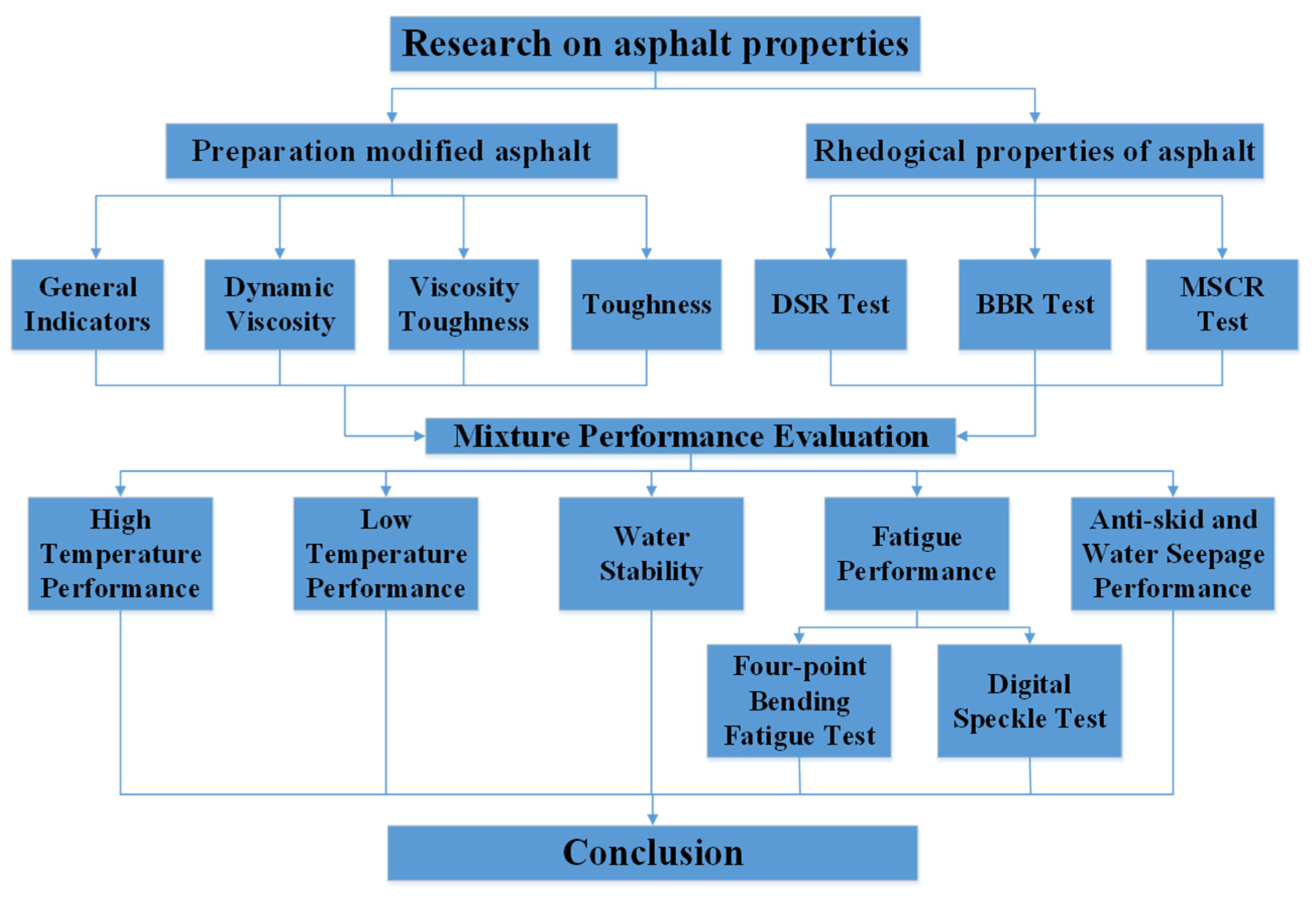
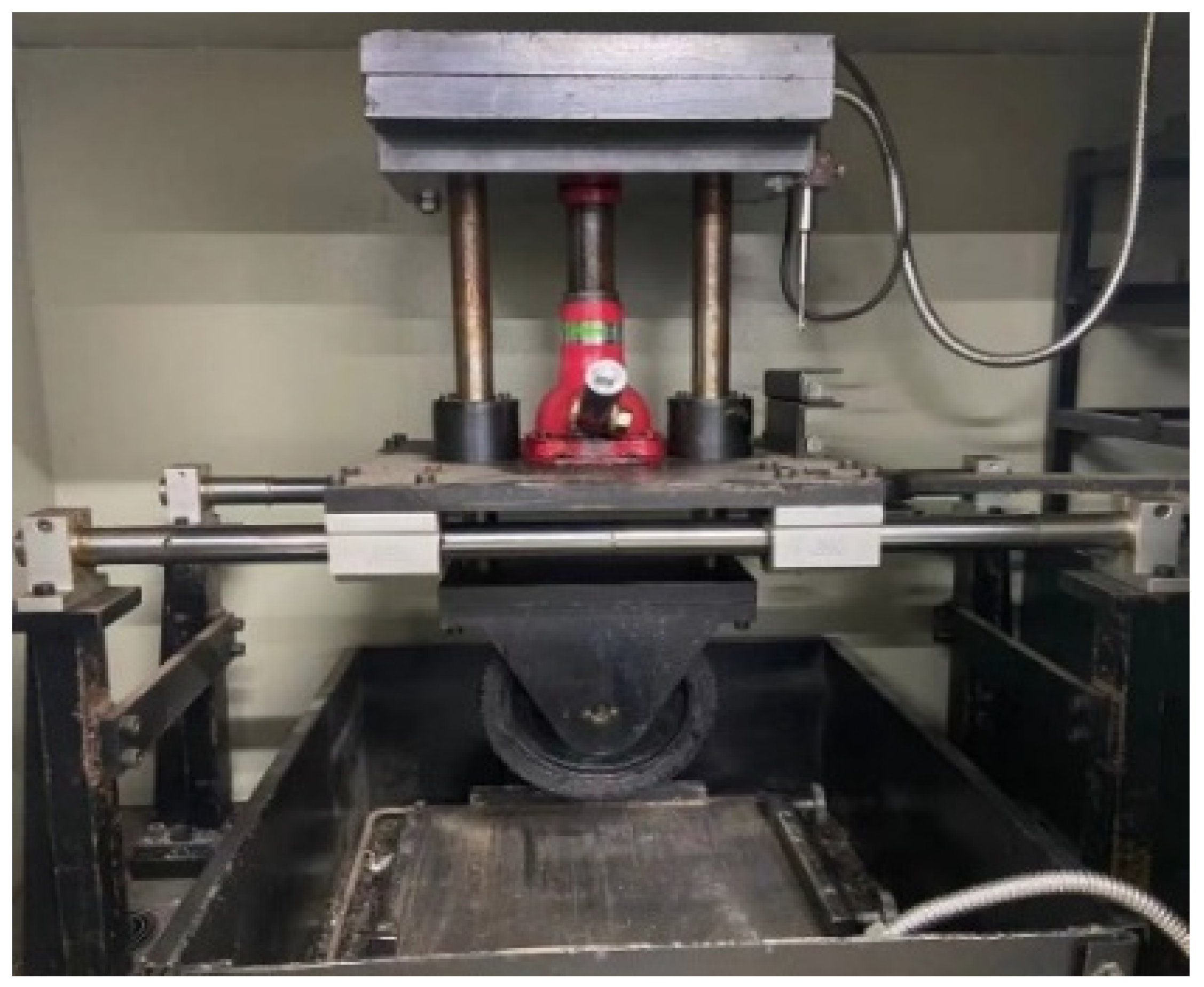

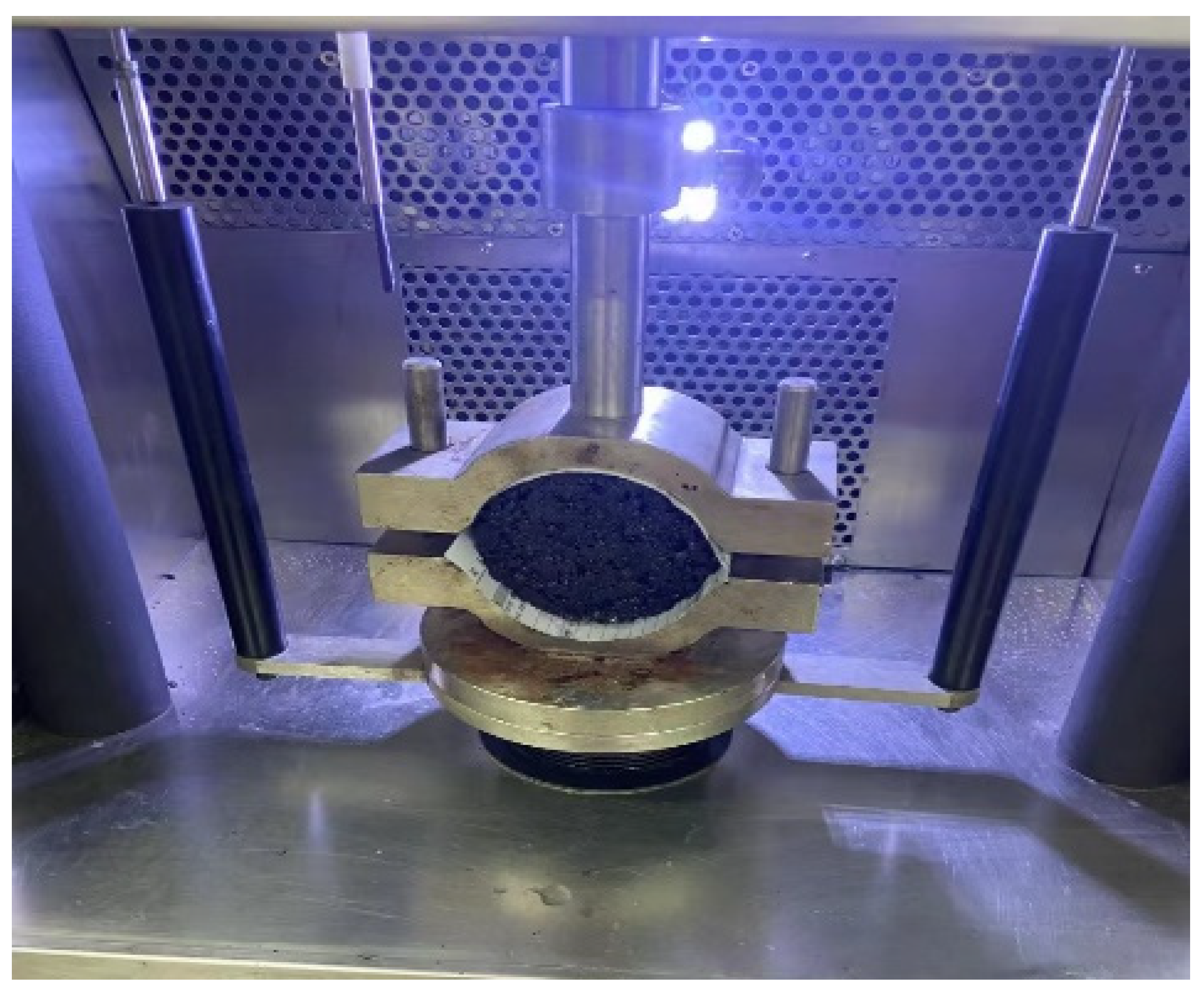
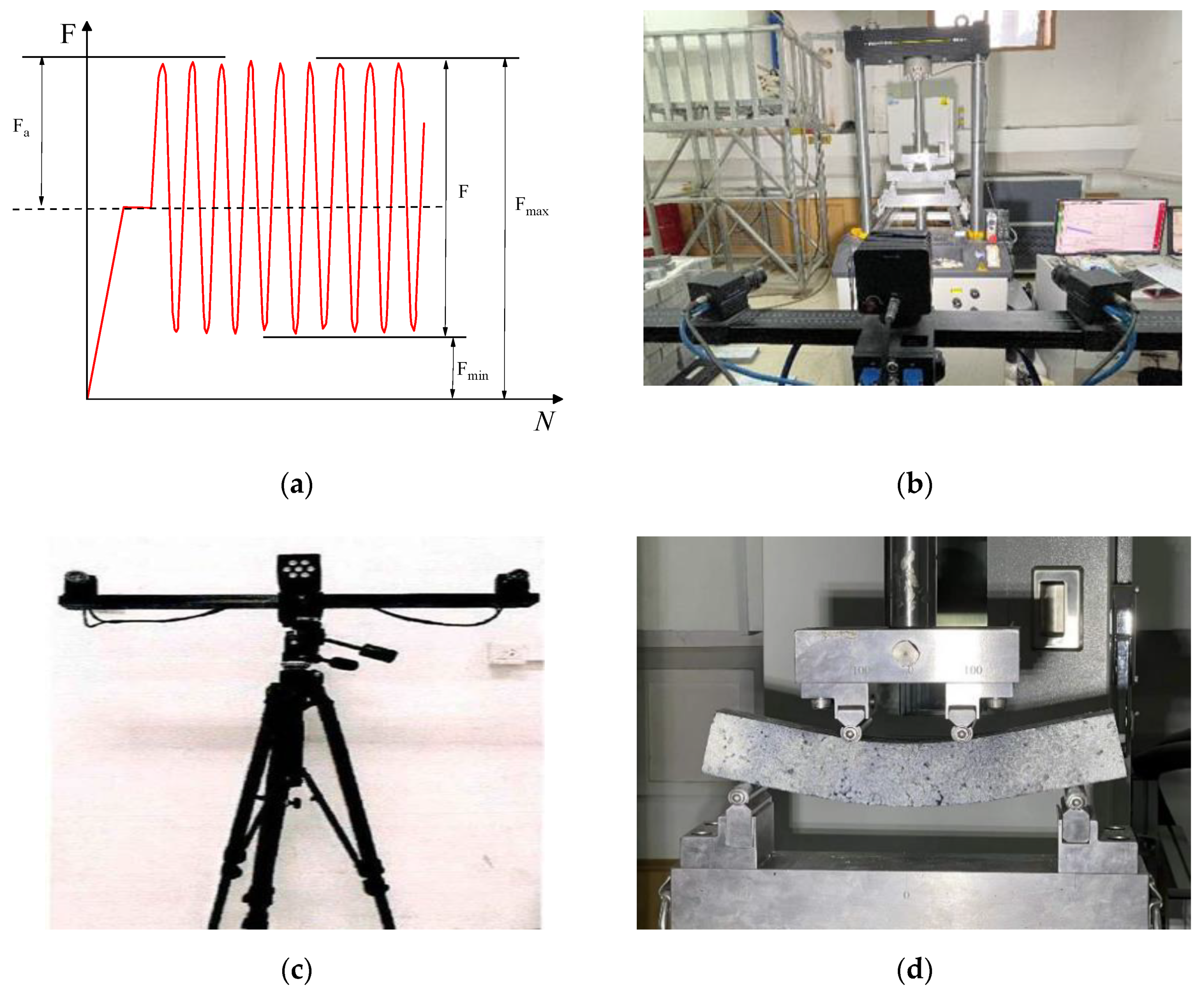
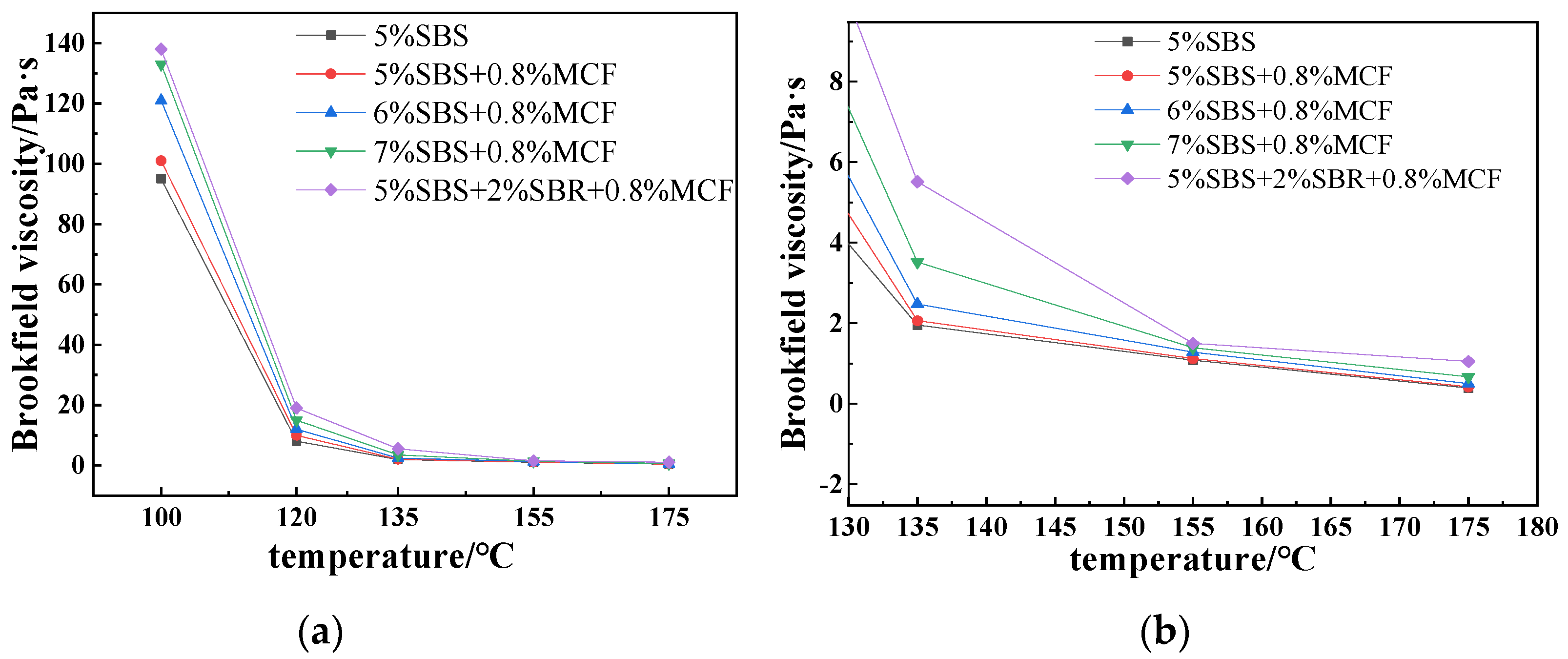
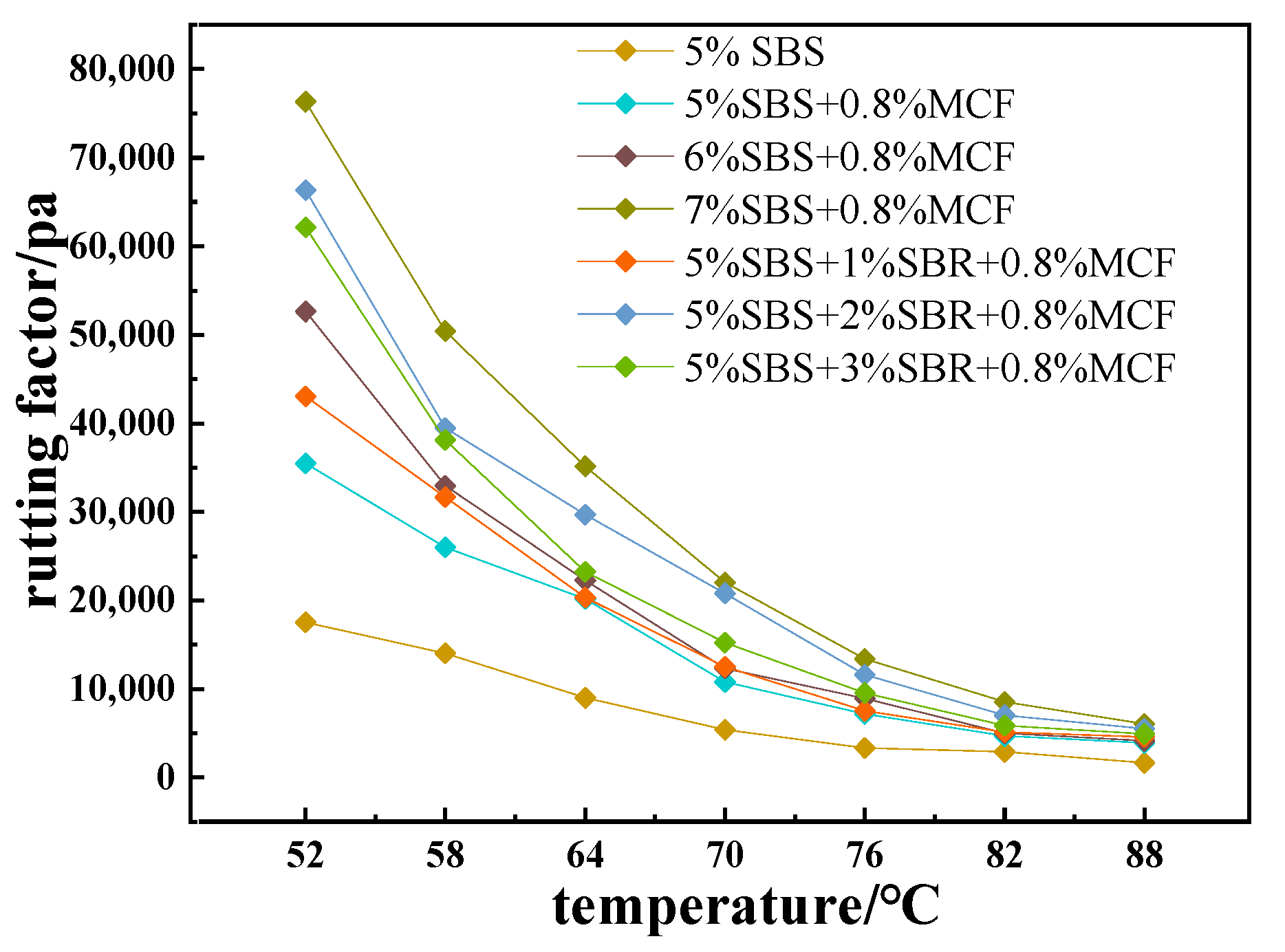
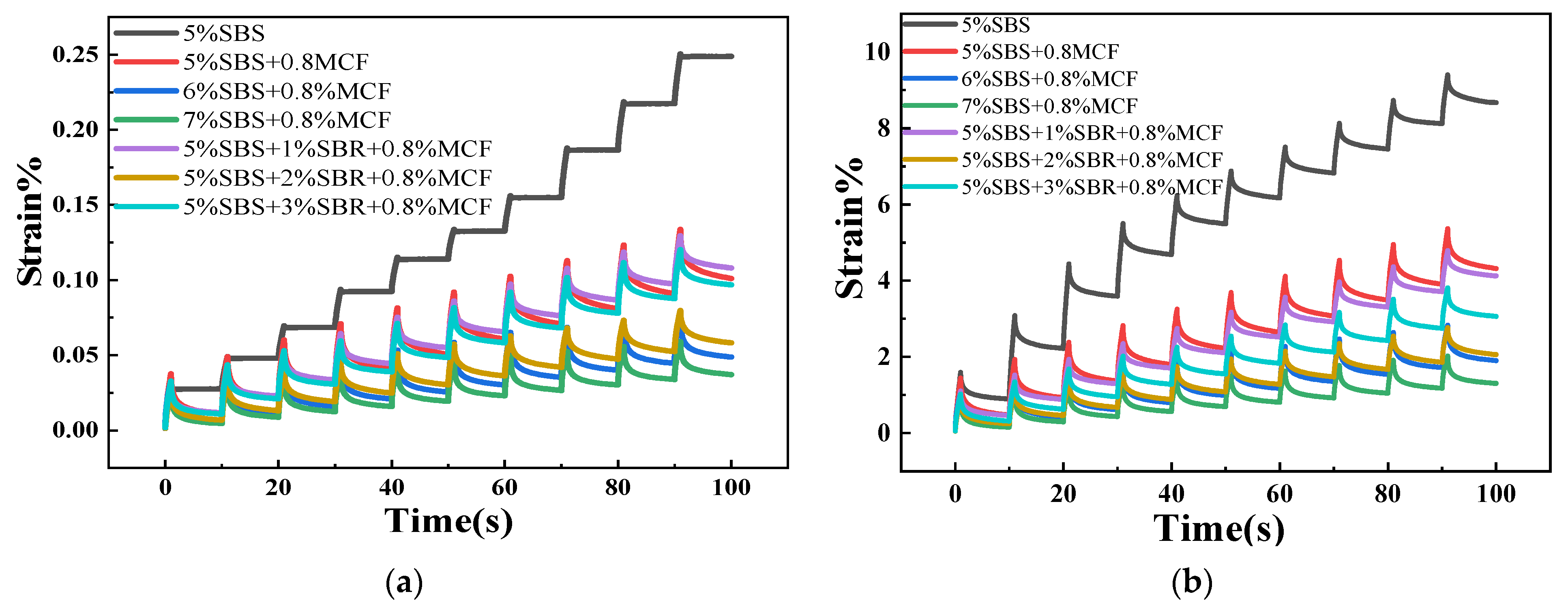

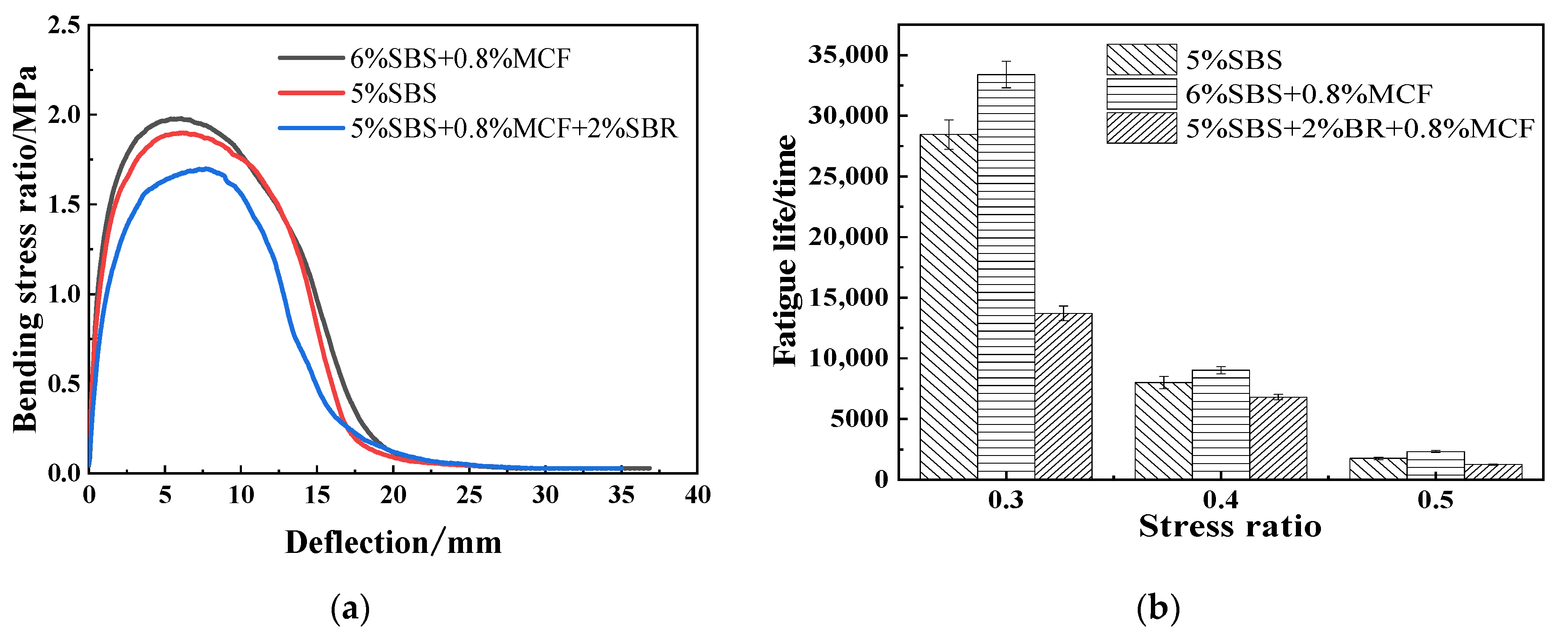
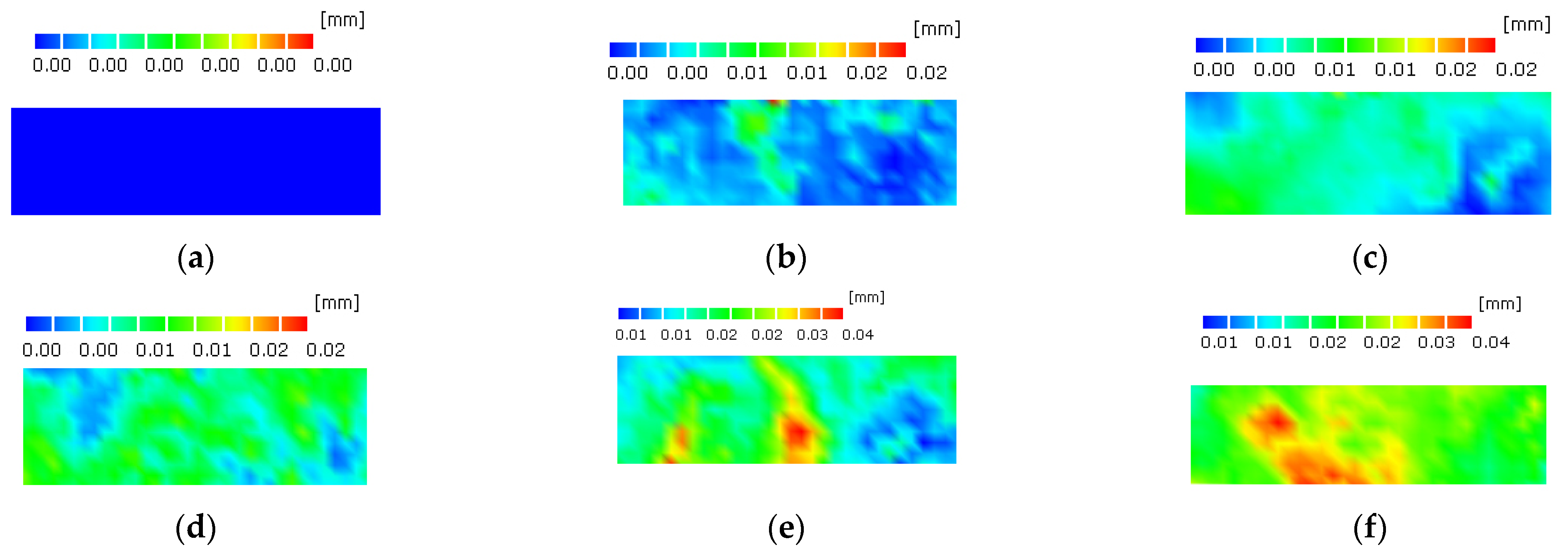

| Performance Indicators | Penetration (25 °C)/0.1 mm | Ductility (10 °C)/cm | Softening Point/°C | Flash Point/°C | Wax Content/% | Density (15 °C)/(g·cm−3) |
|---|---|---|---|---|---|---|
| Test results | 63.8 ± 0.3 | 52 ± 2 | 47 ± 1 | 320 ± 5 | 1.5 ± 0.2 | 1.032 ± 0.003 |
| Index | Reference |
|---|---|
| Block Ratio(S/B) | 30/70 |
| Tensile Strength/MPa | >18.0 |
| Elongation/% | >600 |
| Permanent Deformation/% | <40 |
| Shore Hardness(A) | ≥70 |
| Ash/% | 0.1 |
| Volatile Composition/% | ≤0.5 |
| Index | Specification Type (mm) | Density (g/cm3) | Tensile Strength (MPa) | Modulus of Elasticity (GPa) |
|---|---|---|---|---|
| Data results | 0.017 | 1.8 | 4900 | 230 |
| Material Type | Relative Apparent Density | Relative Gross Volume Density | Water Content (%) | Asphalt Absorption Coefficient | Relative Effective Density (g/cm3) |
|---|---|---|---|---|---|
| Basalt 5–10 mm | 2.9307 | 2.8194 | 1.3511 | 0.60 | 2.8859 |
| Basalt 0–3 mm | 2.8689 | 2.8689 | - | 0.93 | 2.8689 |
| Mineral Powder | 2.6335 | 2.6335 | - | - | 2.6335 |
| Sieve Size (mm) | Passing Percentage of Each Sieve Hole (%) | ||||||||
|---|---|---|---|---|---|---|---|---|---|
| 13.2 | 9.5 | 4.75 | 2.36 | 1.18 | 0.6 | 0.3 | 0.15 | 0.075 | |
| Composite Gradation | 100.0 | 98.7 | 43.9 | 25.2 | 21.8 | 18.6 | 16.3 | 14.0 | 12.1 |
| SMA Specification Gradation Upper Limit | 100 | 100 | 60 | 32 | 26 | 22 | 18 | 16 | 13 |
| SMA Specification Gradation Lower Limit | 100 | 90 | 28 | 20 | 14 | 12 | 10 | 9 | 8 |
| SMA Specification Gradation Median | 100 | 95 | 44 | 26 | 20 | 17 | 14 | 12.5 | 10.5 |
| Marshall Indexes | Gross Volume Density (g/cm3) | Maximum Theoretical Density (g/cm3) | Volume of Air Void/% | Voids in Mineral Aggregate (%) | Voids Filled with Asphalt (%) | Stability (kN) | Flow Value (mm) |
|---|---|---|---|---|---|---|---|
| Test Results | 2.452 | 2.555 | 4.0 | 20.3 | 80.1 | 16.5 | 4.9 |
| Specification Requirements | - | - | 3~4 | ≥17.0 | 75~85 | ≥6.0 | - |
| Modified Asphalt Type | Penetration (0.1 mm) | Softening Point (°C) | Ductility (mm) | 60 °C Kinematic Viscosity (kPa·s) | Viscosity Toughness (N·m) | Toughness (N·m) |
|---|---|---|---|---|---|---|
| 5% SBS | 53.77 ± 1.03 | 74.70 ± 0.20 | 29.50 ± 0.75 | 16.00 ± 1.00 | 24.60 ± 0.65 | 16.0 ± 0.20 |
| 0.8% MCF + 5% SBS | 52.40 ± 0.37 | 77.70 ± 0.50 | 33.50 ± 2.50 | 22.00 ± 1.00 | 30.00 ± 1.30 | 22.0 ± 0.00 |
| 0.8% MCF + 6% SBS | 50.77 ± 0.23 | 79.10 ± 0.30 | 34.20 ± 1.40 | 25.00 ± 1.00 | 32.00 ± 1.50 | 23.7 ± 0.35 |
| 0.8% MCF + 7% SBS | 46.30 ± 0.35 | 82.55 ± 0.20 | 34.80 ± 0.85 | 31.25 ± 0.25 | 34.60 ± 2.00 | 24.6 ± 0.45 |
| 0.8% MCF + 5% SBS + 1% SBR | 48.17 ± 0.57 | 76.15 ± 0.20 | 29.00 ± 2.50 | 15.30 ± 0.60 | 30.00 ± 0.20 | 20.4 ± 0.00 |
| 0.8% MCF + 5% SBS + 2% SBR | 46.17 ± 0.27 | 80.15 ± 0.40 | 32.50 ± 1.75 | 42.00 ± 1.00 | 31.30 ± 0.40 | 21.2 ± 0.60 |
| 0.8% MCF + 5% SBS + 3% SBR | 47.40 ± 0.57 | 80.70 ± 0.00 | 27.85 ± 0.50 | 59.85 ± 1.15 | 31.23 ± 1.53 | 18.9 ± 0.25 |
| Asphalt Type | 5% SBS + 0.0% MCF | 5% SBS + 0.8% MCF | 6% SBS + 0.8%MCF | 7% SBS + 0.8% MCF | 5% SBS + 1% SBR + 0.8% MCF | 5% SBS + 2% SBR + 0.8% MCF | 5% SBS + 3% SBR + 0.8% MCF |
|---|---|---|---|---|---|---|---|
| Jnr0.1/kPa−1 | 0.25 ± 0.01 | 0.10 ± 0.01 | 0.05 ± 0.00 | 0.04 ± 0.00 | 0.10 ± 0.00 | 0.06 ± 0.00 | 0.09 ± 0.01 |
| Jnr3.2/kPa−1 | 0.27 ± 0.01 | 0.13 ± 0.00 | 0.06 ± 0.00 | 0.04 ± 0.00 | 0.10 ± 0.01 | 0.07 ± 0.00 | 0.09 ± 0.00 |
| R0.1/% | 46.91 ± 0.12 | 75.10 ± 0.10 | 85.17 ± 0.13 | 85.68 ± 0.10 | 65.17 ± 0.08 | 77.92 ± 0.10 | 70.17 ± 0.09 |
| R3.2/% | 47.07 ± 0.08 | 70.38 ± 0.12 | 82.81 ± 0.12 | 84.54 ± 0.10 | 61.15 ± 0.11 | 96.36 ± 0.12 | 70.40 ± 0.10 |
| Mixture Type | DS/(Time·mm−1) | Failure Strain | TSR (%) |
|---|---|---|---|
| 5% SBS | 5045 ± 26 | 2867 ± 20 | 90.6 ± 0.3 |
| 0.8% MCF + 5% SBS | 5625 ± 16 | 3226 ± 15 | 91.3 ± 0.2 |
| 0.8% MCF + 6% SBS | 6774 ± 28 | 3578 ± 31 | 93.5 ± 0.1 |
| 0.8% MCF + 7% SBS | 8362 ± 17 | 3447 ± 15 | 95.3 ± 0.1 |
| 0.8% MCF + 5% SBS + 2% SBR | 11,455 ± 25 | 3256 ± 23 | 95.6 ± 0.2 |
| Mixture Type | Friction Coefficient BPN | Depth (mm) | Water Permeability Coefficient (mL/min) |
|---|---|---|---|
| 5% SBS | 81 ± 2 | 0.72 ± 0.05 | 76 ± 2 |
| 6% SBS + 0.8% MCF | 85 ± 2 | 0.98 ± 0.06 | 77 ± 1 |
| 5% SBS + 2% SBR + 0.8% MCF | 87 ± 1 | 1.04 ± 0.05 | 80 ± 2 |
Publisher’s Note: MDPI stays neutral with regard to jurisdictional claims in published maps and institutional affiliations. |
© 2022 by the authors. Licensee MDPI, Basel, Switzerland. This article is an open access article distributed under the terms and conditions of the Creative Commons Attribution (CC BY) license (https://creativecommons.org/licenses/by/4.0/).
Share and Cite
Zhao, Q.; Jing, S.; Lu, X.; Liu, Y.; Wang, P.; Sun, M.; Wang, L. The Properties of Micro Carbon Fiber Composite Modified High-Viscosity Asphalts and Mixtures. Polymers 2022, 14, 2718. https://doi.org/10.3390/polym14132718
Zhao Q, Jing S, Lu X, Liu Y, Wang P, Sun M, Wang L. The Properties of Micro Carbon Fiber Composite Modified High-Viscosity Asphalts and Mixtures. Polymers. 2022; 14(13):2718. https://doi.org/10.3390/polym14132718
Chicago/Turabian StyleZhao, Quanman, Shuo Jing, Xiaojin Lu, Yao Liu, Peng Wang, Min Sun, and Li Wang. 2022. "The Properties of Micro Carbon Fiber Composite Modified High-Viscosity Asphalts and Mixtures" Polymers 14, no. 13: 2718. https://doi.org/10.3390/polym14132718
APA StyleZhao, Q., Jing, S., Lu, X., Liu, Y., Wang, P., Sun, M., & Wang, L. (2022). The Properties of Micro Carbon Fiber Composite Modified High-Viscosity Asphalts and Mixtures. Polymers, 14(13), 2718. https://doi.org/10.3390/polym14132718






